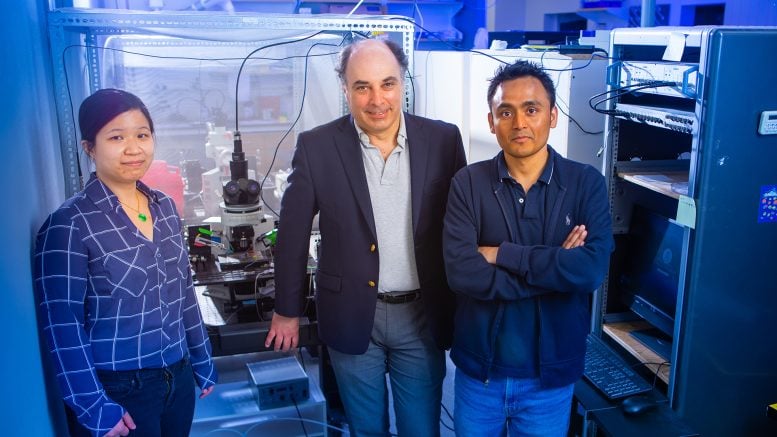
The discovery might have far-reaching consequences for the treatment of brain diseases caused by abnormalities in synaptic information processing and exchange.
Enzymes are used by biochemists to alter how brain cells interact with one another
While you read this sentence, the neurons in your brain are communicating with one another by firing off quick electrical signals. They communicate with one another via synapses, which are tiny, specialized junctions.
There are many various kinds of synapses that develop between neurons, including “excitatory” and “inhibitory,” and scientists are still unsure of the specific methods by which these structures are formed. A biochemistry team has provided significant insight into this topic by demonstrating that the types of chemicals produced from synapses ultimately determine which types of synapses occur between neurons.

From left: Nicole Wong and Matthew Xu-Friedman of the University at Buffalo, and Soham Chanda, assistant professor in the Department of Biochemistry and Molecular Biology at CSU. Credit: Douglas Levere/University at Buffalo
A team of researchers from Colorado State University, University at Buffalo, Stanford University, and California State University, Fullerton conducted the research.
Soham Chanda, assistant professor in the Department of Biochemistry and Molecular Biology at Colorado State University, led the study published in Nature Communications that demonstrates the possibility of changing the identity of synapses between neurons, both in vitro and in vivo, through enzymatic means. The other senior scientists who contributed to the project were Thomas Südhof of Stanford University and Matthew Xu-Friedman of the University at Buffalo.
In the lab, Chanda and colleagues were able to make synapse changes between excitatory and inhibitory types, using only enzymes, by making the neurons express just a few genes that induced a cascade of changes in the synapses’ machinery. Such a breakthrough could have major implications for treating brain diseases that are caused by malfunctions in synaptic information processing and exchange.
“We know very little about how the human brain functions, and at the center of it, we need to understand how neurons communicate with each other,” Chanda said. “Understanding the fundamental mechanisms of synapse formation and maintenance has tremendous implications in understanding brain disorders.”
Their results show that the cell-adhesion proteins expressed in the synaptic junction area are not the only purveyors of the synapses’ function, as some have thought; rather, chemicals called neurotransmitters that are released from the presynaptic site (where the information is coming from) also seem to play a major role in controlling which types of synapses form, and where.
The CSU team used stem cell-derived human neurons to demonstrate their ability to produce certain types of synaptic connections by the controlled release of specific neurotransmitters. Collaborators at the University at Buffalo showed the same phenomenon in live mouse brains.
“Synapses need lots of other machinery; the neurons took care of all that and turned excitatory synapses into inhibitory ones – a fundamental change in their identity,” Xu-Friedman said.
Chanda is fascinated by neurons, “because no other cell type in the human body has the same level of functional complexity that is tied so closely to their shape and structure.”
University at Buffalo biological sciences researchers Matthew A. Xu-Friedman and Nicole F. Wong also made significant contributions, with Xu-Friedman serving as a senior author alongside Stanford University’s Chanda and Thomas C. Südhof, and Wong serving as a first author alongside Colorado State University’s Scott R. Burlingham and Lindsay Peterkin. Chanda earned his Ph.D. in Xu-Friedman’s lab at the University at Buffalo over a decade ago and finished his postdoctoral studies in Südhof’s group at Stanford in 2018.
The study was funded by Colorado State University and the National Institutes of Health.
Reference: “Induction of synapse formation by de novo neurotransmitter synthesis” by Scott R. Burlingham, Nicole F. Wong, Lindsay Peterkin, Lily Lubow, Carolina Dos Santos Passos, Orion Benner, Michael Ghebrial, Thomas P. Cast, Matthew A. Xu-Friedman, Thomas C. Südhof, and Soham Chanda, 1 June 2022, Nature Communications.
DOI: 10.1038/s41467-022-30756-z









Be the first to comment on "Stanford Biochemists Successfully Change How the Brain Communicates With Itself"